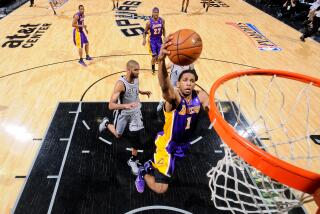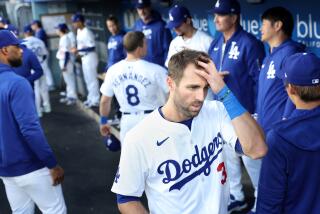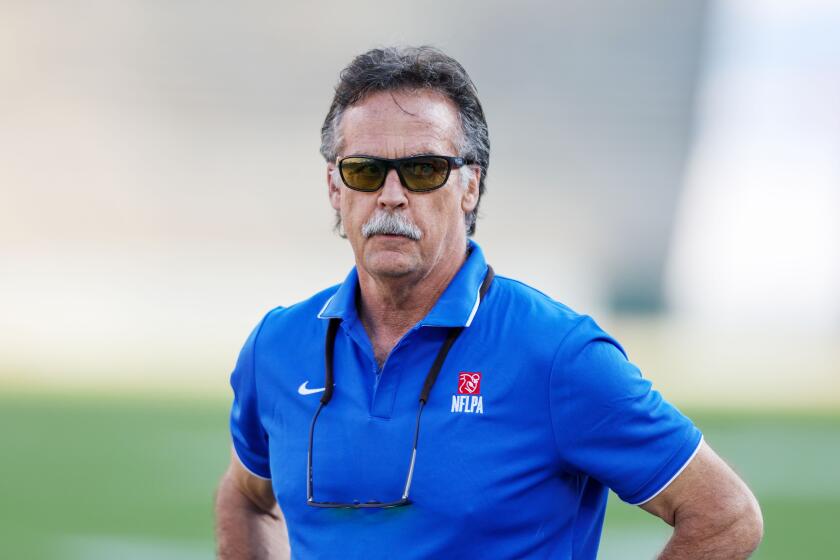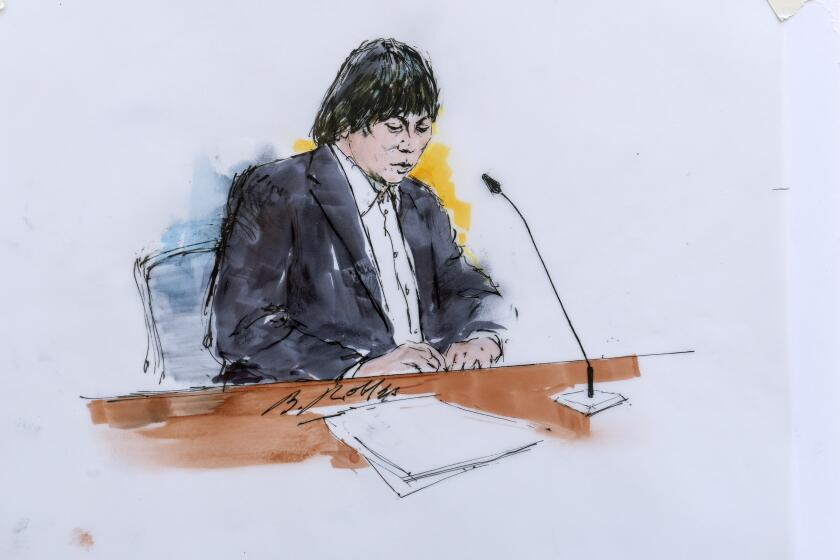MOTOR RACING INDIANAPOLIS 500 QUALIFYING : Show Begins With Four Laps of Pressure
The Indianapolis 500, with its estimated 400,000 spectators, is the world’s largest single-day sporting event, but what is the second-largest motor racing event in the country?
The Daytona 500? The Long Beach Grand Prix?
Try Indy qualifying. There will be 200,000 here today for pole day time trials when Indy car drivers begin to fill the 33-car starting field for the race May 26. Normally, qualifying is little more than a prelude to the race, but in the mystique of Indy, the time trials are a ritual unto themselves.
“Qualifying here is one of the highest pressures we face in driving,” said Rick Mears, who has sat on the pole a record five times in his 13 years at Indy. “The way the time trials are held here, it’s like running two races instead of one. The first race is qualifying. The second race is the race itself.
“As for the pressure, qualifying day is one of the most demanding times we face all season. In the race, you have 500 miles to try to make corrections (in the handling) on the car. In qualifying you know that you have only four laps, and if you are competitive and taking a shot at the pole and blow one corner, you blow all four laps.”
Mears came close to missing his chance for another pole when a wheel nut broke on his Penske-Chevy during practice Friday. He crashed in the first turn and was taken to Methodist Hospital for treatment of a foot injury, but he was back on the track later in his backup car and is expected to be ready to go today.
Time trials for the 500 consist of drivers, who have drawn for positions in line, taking four consecutive laps--10 miles--alone on the 2 1/2-mile rectangular oval.
“Going one at a time is a better show for the public,” said Emerson Fittipaldi, the two-time world champion from Brazil who shattered all Indy records last year with one lap at 225.575 m.p.h. and four laps at 225.301. “It is fairer, too. In Grand Prix qualifying (during which many cars are on the track at the same time), you are facing many different situations that can work against you. You can run up on a slow car on your quick lap or you can be affected by oil from other cars on the track at the same time, different things.
“This way puts more pressure on the driver, but in my opinion it is the best way to qualify.”
The pole goes to the driver who records the fastest average speed for four laps on the first of four days of qualifying--unless weather prevents the full qualifying entry from getting at least one opportunity to run.
It wasn’t always that way.
Until 1971, the pole went to the fastest first-day qualifier even if everyone didn’t get a chance to qualify. When the horn sounded at 6 p.m., it was all over, no matter who was waiting in line.
A freak circumstance on the first day of qualifying in 1969 led to a change in the rules. On that day, a nagging drizzle delayed the trials until 4 p.m. Jigger Sirois, a journeyman driver and an Indianapolis rookie, had drawn the No. 1 qualifying position, but after taking three laps, his car owner, Myron Caves of Fresno, was not satisfied with the speed and displayed a yellow flag, aborting the run.
Before the next driver could take the green flag, the rain returned and did not stop for two days. Had Sirois completed his four laps at his three-lap average of nearly 162 m.p.h., he would have been the pole sitter.
When United States Auto Club officials realized how close they had come to having a rookie driver in a 162-m.p.h. car in front of a pack of 170-m.p.h. cars--A. J. Foyt was top qualifier at 170.586--they changed the qualifying rules, allowing all who had drawn for position to run for the pole.
If the words, “Gentlemen, start your engines,” stir the souls of fans before the 500, then public address announcer Tom Carnegie’s stentorian cry, “Heeeeezzzzz on it,” brings everyone to attention during qualifying.
As each driver takes the green flag from starter Duane Sweeney, Carnegie makes his call.
And Carnegie’s words, “It’s a new track record,” guarantee an explosive cheer.
In the last decade, that has become commonplace. Records have been set every year but one since 1981 as the speeds moved up from Mears’ 207.004 in 1982 to Fittipaldi’s 225.301 last year.
As was the case with Sirois, though, not everyone completes his four laps. A driver can slow on his own, or an attempt can be stopped by a team official waving a yellow flag at the top of the front straightaway. Each entry is given three chances to qualify, but once he has four laps and an official time, that time stands.
Besides the shot at the pole, there is a premium on first-day qualifying. For the 500, cars line up not just according to speed, but according to qualifying day. First-day qualifiers are followed by second-day qualifiers--even if some are faster than first-day qualifiers--then the third- and fourth-day qualifiers fill the field.
When the field is full, 33 cars qualified, the remaining cars still eligible may continue to attempt to better the speed of the slower qualifiers. This is called “bumping,” and the slowest driver is said to be “on the bubble.”
Cars--not drivers--qualify, so once a car is bumped, it is out and may not return. The driver of a bumped car may get a second chance in a different car. In some cases, when drivers are injured or have scheduling conflicts, as did Mario Andretti when he was commuting to Formula One races a few years ago, a substitute driver will qualify a car for the assigned driver. However, he must start at the rear of the field.
If a car is crashed or destroyed after it qualifies, its driver may switch to a backup car but also must go to the rear of the field. Tom Sneva totaled his car during practice after qualifying in 1980, started 33rd in his backup and finished second.
The winner of the pole will receive the PPG Cup award of $100,000 but being on the bubble is worth something, too. The driver on the bubble collects $5,000 and so does the first alternate.
Besides today, qualifying is scheduled Sunday and May 18-19. The most exciting and emotional moments in qualifying often occur late on the final Sunday when the driver on the bubble has to sweat out last-minute attempts that may send him home in frustration. Or, when a driver fails to better the 33rd starter’s speed and is out of the show.
As seemingly innocent a thing as drawing for a position in the qualifying order can influence the winning of the pole.
Last year, Al Unser Jr., the favorite to take the pole after a record 228.502 in practice, not only lost it to Fittipaldi but qualified no better than seventh.
“When Emerson ran his time, it was 5 o’clock in the afternoon.” Unser said. “It was real late on Sunday because we’d been rained out Saturday and the track didn’t open until late Sunday.
“I didn’t get a chance until the following week, and when it was my turn, wouldn’t you know it, it was 80 degrees and the sun was out. It was midday and the track was hot and slippery. We never had a chance. It just depends on conditions at the time your number is called.”
More to Read
Get our high school sports newsletter
Prep Rally is devoted to the SoCal high school sports experience, bringing you scores, stories and a behind-the-scenes look at what makes prep sports so popular.
You may occasionally receive promotional content from the Los Angeles Times.






